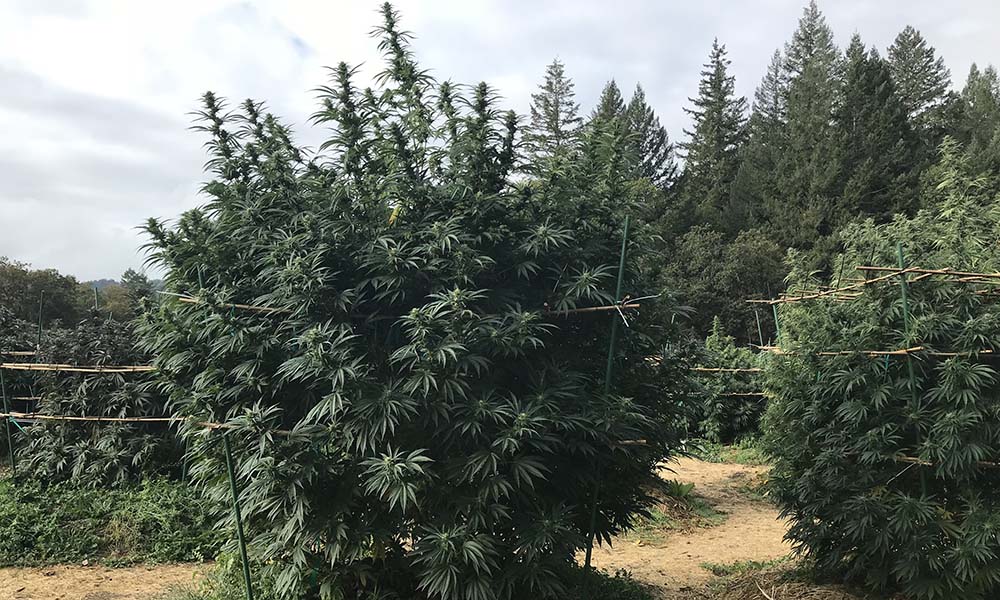
Joint Opinions
A Different Kind of Harvest
This year’s cannabis harvest season in California is the first with new regulations in effect.
Ever since January 1, 2018, when adult-use legalization went into effect in California, we have been riding wave after wave of new regulations. So far we have managed to stay afloat thanks to hard work, flexibility and some good luck. As harvest approaches, however, we face yet another big breaker to surf. Let’s hope it’s not a tsunami!
Harvest season has always been a busy and festive time, with lots of people helping out in many ways to get the plants all cut, dried and trimmed. Traditionally, like most cannabis farmers, we have had workers from all across the globe — from Tibet, Holland, Israel, Germany, England and South America. A wide variety of accents could be heard in the shops and towns across the Emerald Triangle. Trimmigrants would line the highways, fingers outstretched in a scissor cutting motion to signify their skills. Those days are over.
Clearly, the word has gotten out, as there aren’t many young folks flocking to the region for seasonal labor this year. The few of us who actually have permits to grow are now required to hire only California residents who are willing to be fingerprinted, pay taxes and sign contracts. Those who are still operating in the black market, which is the vast majority, must find their help in clever ways and can’t be so obvious about it anymore. While we are being jolted forward into regulations in the new era of legal cannabis, those who aren’t permitted are retreating to their old clandestine ways.
Up in Humboldt County, unpermitted growers are facing a harsh reality, which no doubt will soon spread to other counties. They may awake to find notices from various agencies (Fish & Wildlife, water boards, planning and building, the sheriff, etc.) posted on their gate demanding they “cease and desist” their violations of code such and such. Failure to do so will incur penalties to the tune of $10,000 a pop, per day. Yes, you read that right. An illegal cannabis grower could face easily $30,000 a day in fines. I did read however that they made the generous gesture of putting a cap on it — at $999,000! The only options are to either pull out all the plants immediately and destroy them, apply for a permit right away (but you still have to pay the fines for the days it takes to register your application), or start packing and get out of Dodge.
While we no longer have to worry about helicopters circling above or the sheriff and his posse swooping in, we do have to stay on top of seemingly endless compliance issues.
We also could easily incur huge fines for things such as an unposted permit on a garden gate, an improper use of water or an OSHA complaint and so much more. We can only do our very best and hope we have covered all the necessary bases. Hence, preparing for this harvest has been a whole new ballgame.
Luckily, we can continue to dry and cure our cannabis here on our ranch, but we are no longer allowed to trim and package on site. The reason is that a commercially permitted building is required, with ADA parking and toilet, security cameras and numerous other necessities. The prohibitive cost of that construction project is out of the question for 95 percent of the farmers. However, we still are required by the Environmental Health Department in Mendocino County to have an ADA toilet for the farmers, out near the garden. We rent a port-a-potty — at least it’s green and not bright blue!
The old adage “find a need and fill it” certainly applies to the cannabis business. Some smart entrepreneurs have acquired the necessary permits to open processing companies where farmers can take their bucked (cut down to smaller pieces after drying) cannabis to be trimmed, weighed, packaged and eventually picked up by a distributor. Companies like Flow Kana have been assiduously preparing for this step for a few years while others are just getting into the game. The need and demand are there. But for the farmer, sending the flowers off the farm to be trimmed is like sending your daughters off to college. It’s difficult to let go of the beautiful plants that we sprouted from seeds 6 months ago and have since lovingly nurtured. Now that they are at their very fragrant best, off they go. It can be emotional just thinking about it. Another lesson in non-attachment.
Human nature generally has us stuck in current beliefs and patterns so that when things change so drastically it takes time for the new reality to sink in. Many of our fellow farmers knew the changes were happening, but unless they were actively involved in the process over the past few years, they are just now finding out how drastic those changes are. Cannabis growers generally are pretty laid back people, not exactly the kind who like to read ordinances and regulations, so it might as well be Greek to them. Catching up is a challenge, but the options are what is happening in Humboldt.
I am happy to report that even though everything is permitted and official, with all appropriate paperwork signed, we still are the same people and are still having a great time helping the girls grow. That’s what it’s really all about. The laws will always be there, but they don’t need to halt creativity. I am learning it’s all about being flexible and giving, just as much as it is about pushing to progress. Cannabis teaches us to go with the flow, to open our minds to new ways of experiencing life, to live through all of our senses. Just as we can learn new ways to harvest the plants, we can discover new layers of life.
TELL US, what changes in cannabis have you seen where you live?


























